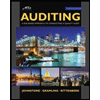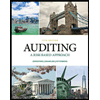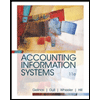
a)
To explain: The three effectiveness goals.
Introduction:
OE/S process:
It is known as the order entry/sales process. It describes the first four steps of the order-to-cash process.
b)
To explain: The particular resources that need to be secured.
Introduction:
OE/S process:
It is known as the order entry/sales process. It describes the first four steps of the order-to-cash process.
c)
To explain: The two data inputs in the system.
Introduction:
OE/S process:
It is known as the order entry/sales process. It describes the first four steps of the order-to-cash process.
d)
To explain: A valid sales order and shipping notice.
Introduction:
OE/S process:
It is known as the order entry/sales process. It describes the first four steps of the order-to-cash process.
Want to see the full answer?
Check out a sample textbook solution
Chapter 10 Solutions
Accounting Information Systems
- What does the term "working capital" refer to?A) Long-term investments of the companyB) Total assets of the companyC) Current assets minus current liabilitiesD) Total liabilities of the companyarrow_forwardWhich of the following represents the primary goal of financial management?A) Maximizing profitsB) Minimizing costsC) Maximizing shareholder wealthD) Maximizing market sharearrow_forwardLet S = $100, K = $95, r = 8% (continuously compounded), σ = 30%, δ = 0, T = 1 year, and n = 3. Verify that the binomial option price for an American call option is $18.283. Verify that there is never early exercise; hence, a European call would have the same price. Show that the binomial option price for a European put option is $5.979. Verify that put-call parity is satisfied. Verify that the price of an American put is $6.678. Please show this step by step and include formulas so that I can follow along. thank you.arrow_forward
 Accounting Information SystemsAccountingISBN:9781337619202Author:Hall, James A.Publisher:Cengage Learning,
Accounting Information SystemsAccountingISBN:9781337619202Author:Hall, James A.Publisher:Cengage Learning, Cornerstones of Cost Management (Cornerstones Ser...AccountingISBN:9781305970663Author:Don R. Hansen, Maryanne M. MowenPublisher:Cengage Learning
Cornerstones of Cost Management (Cornerstones Ser...AccountingISBN:9781305970663Author:Don R. Hansen, Maryanne M. MowenPublisher:Cengage Learning Auditing: A Risk Based-Approach to Conducting a Q...AccountingISBN:9781305080577Author:Karla M Johnstone, Audrey A. Gramling, Larry E. RittenbergPublisher:South-Western College Pub
Auditing: A Risk Based-Approach to Conducting a Q...AccountingISBN:9781305080577Author:Karla M Johnstone, Audrey A. Gramling, Larry E. RittenbergPublisher:South-Western College Pub Auditing: A Risk Based-Approach (MindTap Course L...AccountingISBN:9781337619455Author:Karla M Johnstone, Audrey A. Gramling, Larry E. RittenbergPublisher:Cengage Learning
Auditing: A Risk Based-Approach (MindTap Course L...AccountingISBN:9781337619455Author:Karla M Johnstone, Audrey A. Gramling, Larry E. RittenbergPublisher:Cengage Learning Accounting Information SystemsFinanceISBN:9781337552127Author:Ulric J. Gelinas, Richard B. Dull, Patrick Wheeler, Mary Callahan HillPublisher:Cengage Learning
Accounting Information SystemsFinanceISBN:9781337552127Author:Ulric J. Gelinas, Richard B. Dull, Patrick Wheeler, Mary Callahan HillPublisher:Cengage Learning




